1. Gil JM, Rego AC. Mechanisms of neurodegeneration in Huntington's disease. Eur J Neurosci. 2008; 27:2803–2820. PMID:
18588526.

2. Semaka A, Creighton S, Warby S, Hayden MR. Predictive testing for Huntington disease: interpretation and significance of intermediate alleles. Clin Genet. 2006; 70:283–294. PMID:
16965319.

3. Ahmed I, Sbodio JI, Harraz MM, Tyagi R, Grima JC, Albacarys LK, Hubbi ME, Xu R, Kim S, Paul BD, Snyder SH. Huntington's disease: neural dysfunction linked to inositol polyphosphate multikinase. Proc Natl Acad Sci U S A. 2015; 112:9751–9756. PMID:
26195796.

4. Sepers MD, Raymond LA. Mechanisms of synaptic dysfunction and excitotoxicity in Huntington's disease. Drug Discov Today. 2014; 19:990–996. PMID:
24603212.

5. Ueda M, Li S, Itoh M, Hayakawa-Yano Y, Wang MX, Hayakawa M, Hasebe-Matsubara R, Ohta K, Ohta E, Mizuno A, Hida Y, Matsumoto M, Chen H, Nakagawa T. Polyglutamine expansion disturbs the endoplasmic reticulum formation, leading to caspase-7 activation through Bax. Biochem Biophys Res Commun. 2014; 443:1232–1238. PMID:
24388981.

6. Quintanilla RA, Jin YN, von Bernhardi R, Johnson GV. Mitochondrial permeability transition pore induces mitochondria injury in Huntington disease. Mol Neurodegener. 2013; 8:45. PMID:
24330821.

7. Jenkins BG, Koroshetz WJ, Beal MF, Rosen BR. Evidence for impairment of energy metabolism in vivo in Huntington's disease using localized 1H NMR spectroscopy. Neurology. 1993; 43:2689–2695. PMID:
8255479.
8. Feigin A, Leenders KL, Moeller JR, Missimer J, Kuenig G, Spetsieris P, Antonini A, Eidelberg D. Metabolic network abnormalities in early Huntington's disease: an [(18)F]FDG PET study. J Nucl Med. 2001; 42:1591–1595. PMID:
11696626.
9. Costa V, Scorrano L. Shaping the role of mitochondria in the pathogenesis of Huntingtons disease. EMBO J. 2012; 31:1853–1864. PMID:
22446390.

10. Choi YS, Lee B, Cho HY, Reyes IB, Pu XA, Saido TC, Hoyt KR, Obrietan K. CREB is a key regulator of striatal vulnerability in chemical and genetic models of Huntington's disease. Neurobiol Dis. 2009; 36:259–268. PMID:
19632326.

11. Bhat AH, Dar KB, Anees S, Zargar MA, Masood A, Sofi MA, Ganie SA. Oxidative stress, mitochondrial dysfunction and neurodegenerative diseases; a mechanistic insight. Biomed Pharmacother. 2015; 74:101–110. PMID:
26349970.

12. Jung YJ, Suh EC, Lee KE. Oxygen/glucose deprivation and reperfusion cause modifications of postsynaptic morphology and activity in the CA3 area of organotypic hippocampal slice cultures. Korean J Physiol Pharmacol. 2012; 16:423–429. PMID:
23269905.

13. Wang X, Stavchansky S, Bowman PD, Kerwin SM. Cytoprotective effect of caffeic acid phenethyl ester (CAPE) and catechol ring-fluorinated CAPE derivatives against menadione-induced oxidative stress in human endothelial cells. Bioorg Med Chem. 2006; 14:4879–4887. PMID:
16580214.

14. Michaluart P, Masferrer JL, Carothers AM, Subbaramaiah K, Zweifel BS, Koboldt C, Mestre JR, Grunberger D, Sacks PG, Tanabe T, Dannenberg AJ. Inhibitory effects of caffeic acid phenethyl ester on the activity and expression of cyclooxygenase-2 in human oral epithelial cells and in a rat model of inflammation. Cancer Res. 1999; 59:2347–2352. PMID:
10344742.
15. Lee KW, Chun KS, Lee JS, Kang KS, Surh YJ, Lee HJ. Inhibition of cyclooxygenase-2 expression and restoration of gap junction intercellular communication in H-ras-transformed rat liver epithelial cells by caffeic acid phenethyl ester. Ann N Y Acad Sci. 2004; 1030:501–507. PMID:
15659835.

16. Juman S, Yasui N, Ikeda K, Ueda A, Sakanaka M, Negishi H, Miki T. Caffeic acid phenethyl ester suppresses the production of proinflammatory cytokines in hypertrophic adipocytes through lipopolysaccharide-stimulated macrophages. Biol Pharm Bull. 2012; 35:1941–1946. PMID:
23123466.

17. Murtaza G, Karim S, Akram MR, Khan SA, Azhar S, Mumtaz A, Bin Asad MH. Caffeic acid phenethyl ester and therapeutic potentials. Biomed Res Int. 2014; DOI:
10.1155/2014/145342.

18. Kokoszko-Bilska A, Stepniak J, Lewinski A, Karbownik-Lewinska M. Protective antioxidative effects of caffeic acid phenethyl ester (CAPE) in the thyroid and the liver are similar to those caused by melatonin. Thyroid Res. 2014; 7:5. PMID:
25009581.

19. Kassim M, Mansor M, Kamalden TA, Shariffuddin II, Hasan MS, Ong G, Sekaran SD, Suhaimi A, Al-Abd N, Yusoff KM. Caffeic acid phenethyl ester (CAPE): scavenger of peroxynitrite in vitro and in sepsis models. Shock. 2014; 42:154–160. PMID:
24667629.
20. Saulle E, Gubellini P, Picconi B, Centonze D, Tropepi D, Pisani A, Morari M, Marti M, Rossi L, Papa M, Bernardi G, Calabresi P. Neuronal vulnerability following inhibition of mitochondrial complex II: a possible ionic mechanism for Huntington\'s disease. Mol Cell Neurosci. 2004; 25:9–20. PMID:
14962736.

21. Huang QY, Wei C, Yu L, Coelho JE, Shen HY, Kalda A, Linden J, Chen JF. Adenosine A2A receptors in bone marrow-derived cells but not in forebrain neurons are important contributors to 3-nitropropionic acid-induced striatal damage as revealed by cell-type-selective inactivation. J Neurosci. 2006; 26:11371–11378. PMID:
17079665.

22. Lee B, Butcher GQ, Hoyt KR, Impey S, Obrietan K. Activity-dependent neuroprotection and cAMP response element-binding protein (CREB): kinase coupling, stimulus intensity, and temporal regulation of CREB phosphorylation at serine 133. J Neurosci. 2005; 25:1137–1148. PMID:
15689550.

23. Koh JY, Choi DW. Quantitative determination of glutamate mediated cortical neuronal injury in cell culture by lactate dehydrogenase efflux assay. J Neurosci Methods. 1987; 20:83–90. PMID:
2884353.

24. Jones BJ, Roberts DJ. The quantitative measurement of motor incoordination in naive mice using an accelerating rotarod. J Pharm Pharmacol. 1968; 20:302–304. PMID:
4384609.

25. Ranju V, Sathiya S, Kalaivani P, Priya RJ, Saravana Babu C. Memantine exerts functional recovery by improving BDNF and GDNF expression in 3-nitropropionic acid intoxicated mice. Neurosci Lett. 2015; 586:1–7. PMID:
25475686.

26. Lobsiger CS, Cleveland DW. Glial cells as intrinsic components of non-cell-autonomous neurodegenerative disease. Nat Neurosci. 2007; 10:1355–1360. PMID:
17965655.

27. Jang M, Lee MJ, Cho IH. Ethyl pyruvate ameliorates 3-nitropropionic acid-induced striatal toxicity through anti-neuronal cell death and anti-inflammatory mechanisms. Brain Behav Immun. 2014; 38:151–165. PMID:
24576481.

28. Yasui N, Nishiyama E, Juman S, Negishi H, Miki T, Yamori Y, Ikeda K. Caffeic acid phenethyl ester suppresses oxidative stress in 3T3-L1 adipocytes. J Asian Nat Prod Res. 2013; 15:1189–1196. PMID:
23927014.

29. Huang Y, Jin M, Pi R, Zhang J, Chen M, Ouyang Y, Liu A, Chao X, Liu P, Liu J, Ramassamy C, Qin J. Protective effects of caffeic acid and caffeic acid phenethyl ester against acrolein-induced neurotoxicity in HT22 mouse hippocampal cells. Neurosci Lett. 2013; 535:146–151. PMID:
23313590.

30. Kurauchi Y, Hisatsune A, Isohama Y, Mishima S, Katsuki H. Caffeic acid phenethyl ester protects nigral dopaminergic neurons via dual mechanisms involving haem oxygenase-1 and brain-derived neurotrophic factor. Br J Pharmacol. 2012; 166:1151–1168. PMID:
22224485.

31. Ilhan A, Iraz M, Gurel A, Armutcu F, Akyol O. Caffeic acid phenethyl ester exerts a neuroprotective effect on CNS against pentylenetetrazol-induced seizures in mice. Neurochem Res. 2004; 29:2287–2292. PMID:
15672552.

32. Eser O, Cosar M, Sahin O, Mollaoglu H, Sezer M, Yaman M, Songur A. The neuroprotective effects of caffeic acid phenethyl ester (CAPE) in the hippocampal formation of cigarette smoke exposed rabbits. Pathology. 2007; 39:433–437. PMID:
17676486.

33. Akyol S, Erdemli HK, Armutcu F, Akyol O. In vitro and in vivo neuroprotective effect of caffeic acid phenethyl ester. J Intercult Ethnopharmacol. 2015; 4:192–193. PMID:
26401406.

34. Kim H, Kim W, Yum S, Hong S, Oh JE, Lee JW, Kwak MK, Park EJ, Na DH, Jung Y. Caffeic acid phenethyl ester activation of Nrf2 pathway is enhanced under oxidative state: structural analysis and potential as a pathologically targeted therapeutic agent in treatment of colonic inflammation. Free Radic Biol Med. 2013; 65:552–562. PMID:
23892357.

35. Scapagnini G, Vasto S, Abraham NG, Caruso C, Zella D, Fabio G. Modulation of Nrf2/ARE pathway by food polyphenols: a nutritional neuroprotective strategy for cognitive and neurodegenerative disorders. Mol Neurobiol. 2011; 44:192–201. PMID:
21499987.

36. Zhang H, Davies KJ, Forman HJ. Oxidative stress response and Nrf2 signaling in aging. Free Radic Biol Med. 2015; 88:314–336. PMID:
26066302.

37. Wang W, Wu Y, Zhang G, Fang H, Wang H, Zang H, Xie T, Wang W. Activation of Nrf2-ARE signal pathway protects the brain from damage induced by epileptic seizure. Brain Res. 2014; 1544:54–61. PMID:
24333359.

38. Wang R, Tu J, Zhang Q, Zhang X, Zhu Y, Ma W, Cheng C, Brann DW, Yang F. Genistein attenuates ischemic oxidative damage and behavioral deficits via eNOS/Nrf2/HO-1 signaling. Hippocampus. 2013; 23:634–647. PMID:
23536494.

39. Stack C, Ho D, Wille E, Calingasan NY, Williams C, Liby K, Sporn M, Dumont M, Beal MF. Triterpenoids CDDO-ethyl amide and CDDO-trifluoroethyl amide improve the behavioral phenotype and brain pathology in a transgenic mouse model of Huntington's disease. Free Radic Biol Med. 2010; 49:147–158. PMID:
20338236.

40. Chen YJ, Huang AC, Chang HH, Liao HF, Jiang CM, Lai LY, Chan JT, Chen YY, Chiang J. Caffeic acid phenethyl ester, an antioxidant from propolis, protects peripheral blood mononuclear cells of competitive cyclists against hyperthermal stress. J Food Sci. 2009; 74:H162–H167. PMID:
19723200.
41. Wu W, Lu L, Long Y, Wang T, Liu L, Chen Q, Wang R. Free radical scavenging and antioxidative activities of caffeic acid phenethyl ester (CAPE) and its related compounds in solution and membranes: a structure-activity insight. Food Chem. 2007; 105:107–115.

42. Bacsi A, Woodberry M, Widger W, Papaconstantinou J, Mitra S, Peterson JW, Boldogh I. Localization of superoxide anion production tomitochondrial electron transport chain in 3-NPA-treated cells. Mitochondrion. 2006; 6:235–244. PMID:
17011837.
43. Akashiba H, Ikegaya Y, Nishiyama N, Matsuki N. Differential involvement of cell cycle reactivation between striatal and cortical neurons in cell death induced by 3-nitropropionic acid. J Biol Chem. 2008; 283:6594–6606. PMID:
18182390.

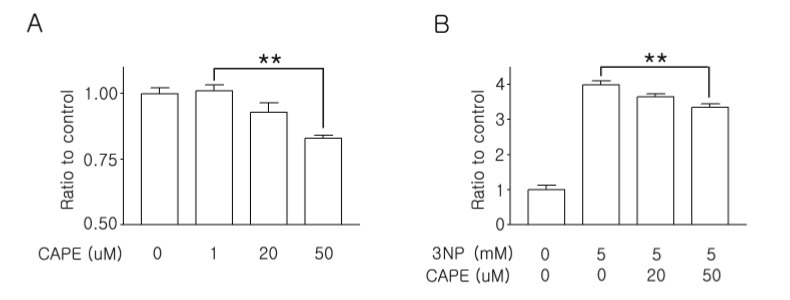
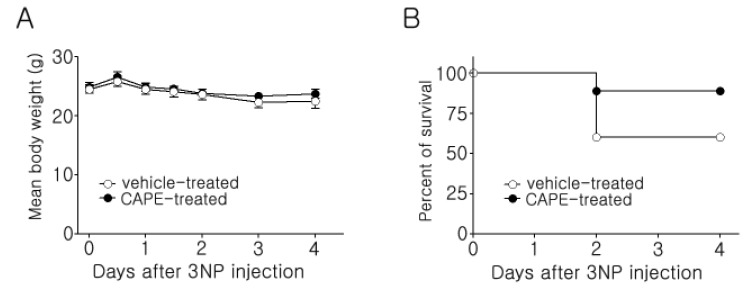
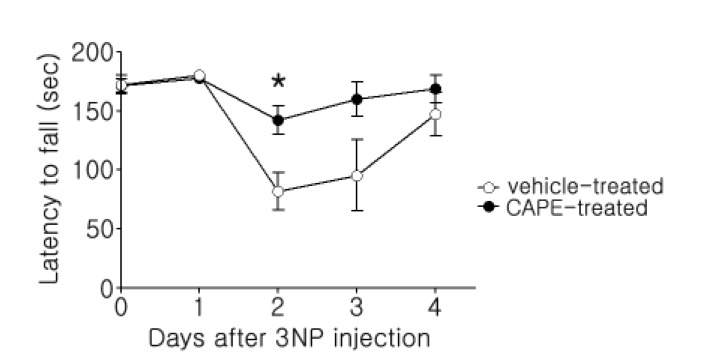
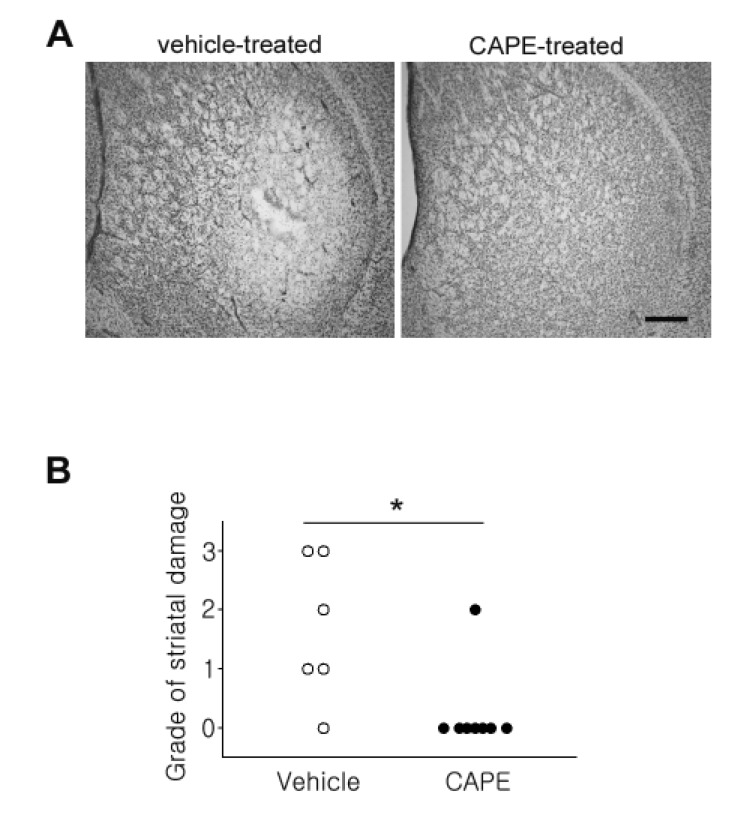
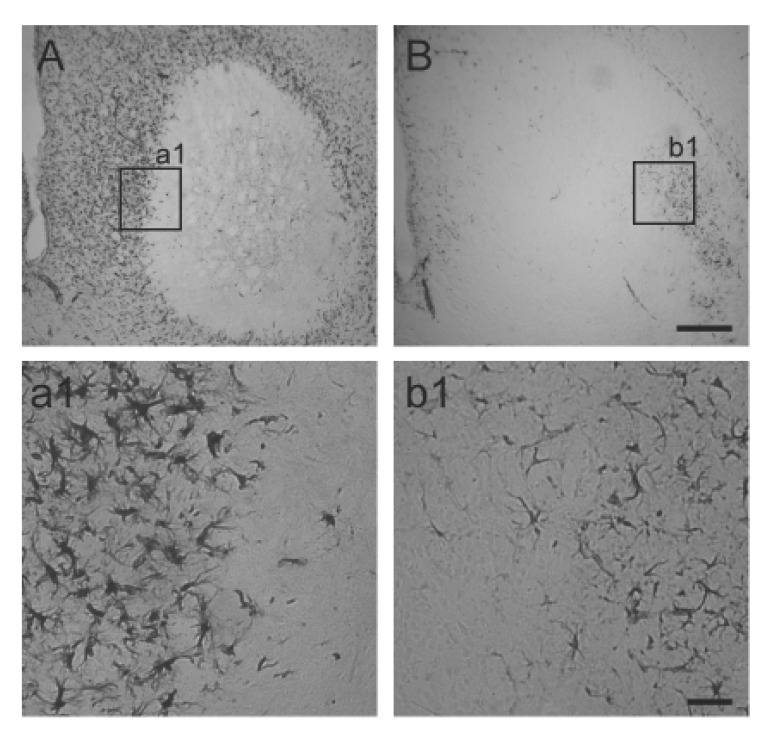
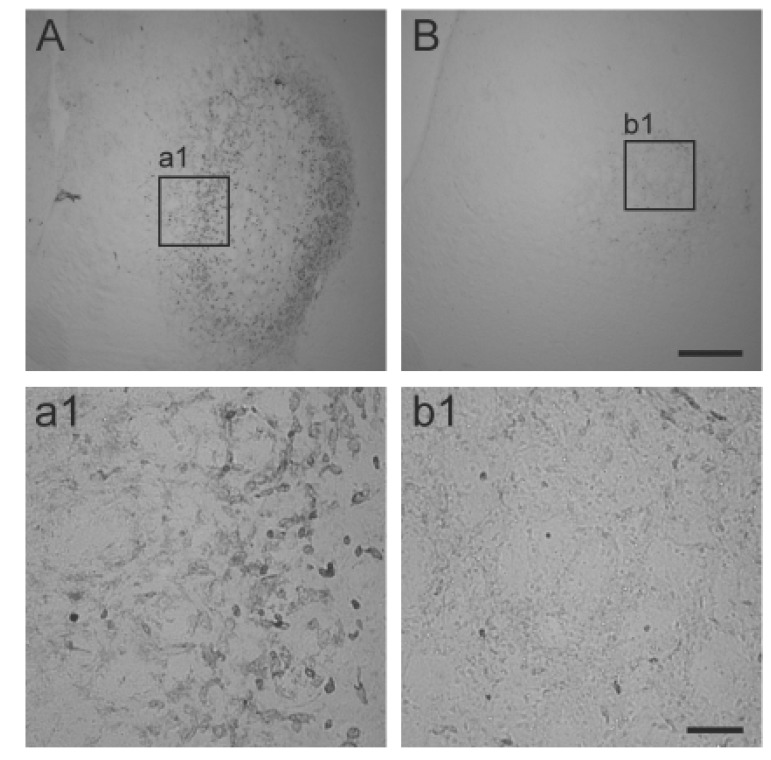




 PDF
PDF ePub
ePub Citation
Citation Print
Print


 XML Download
XML Download